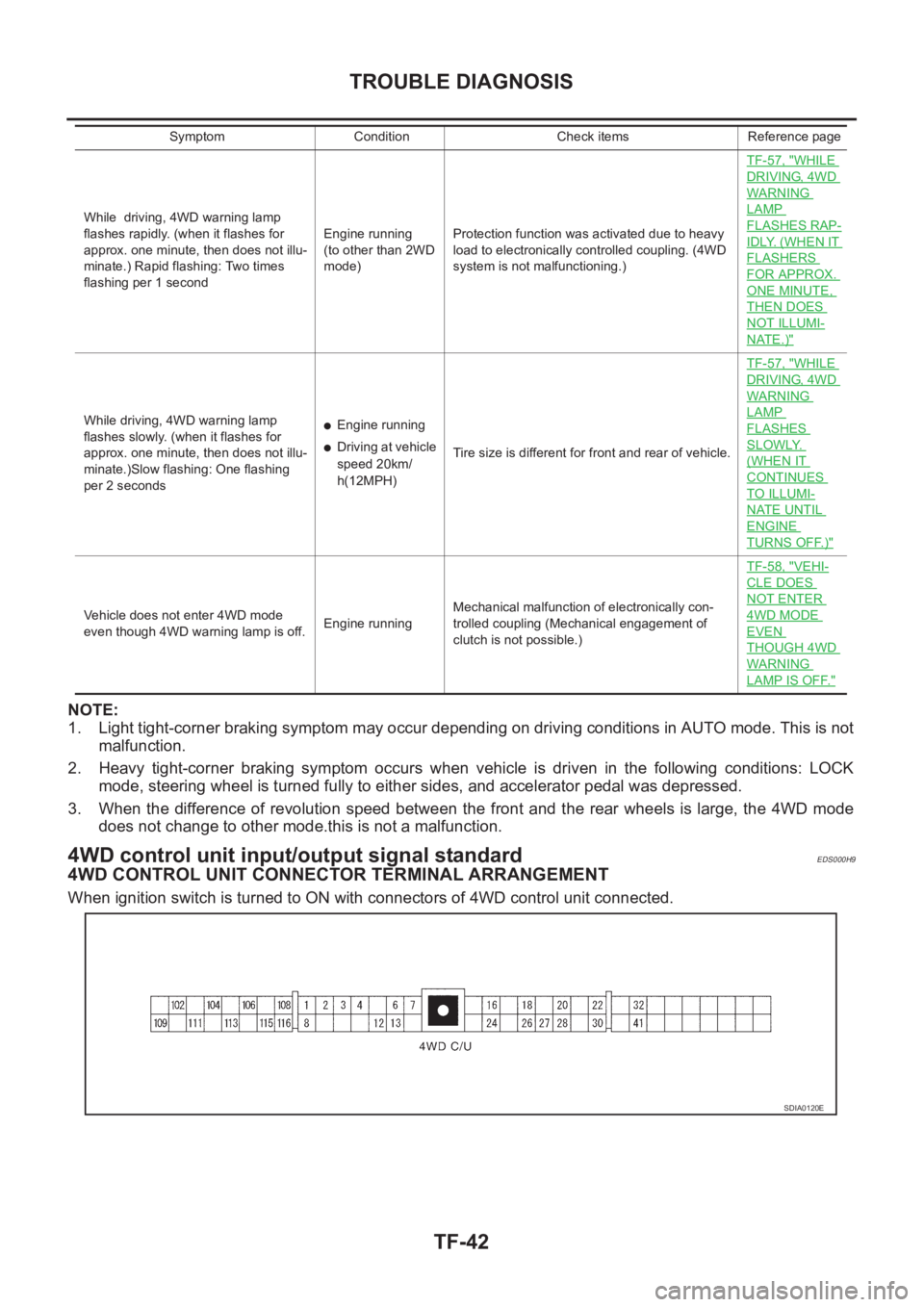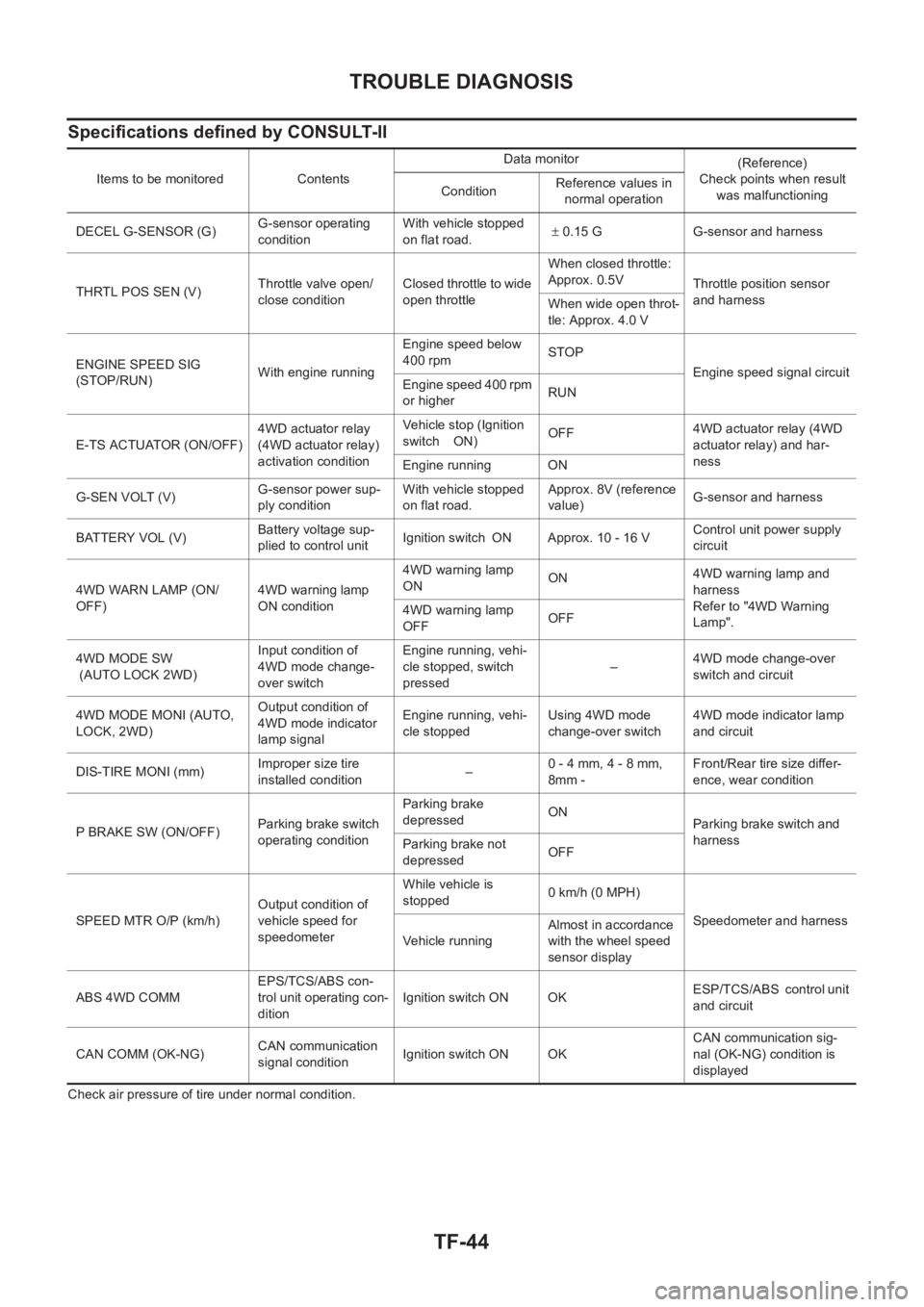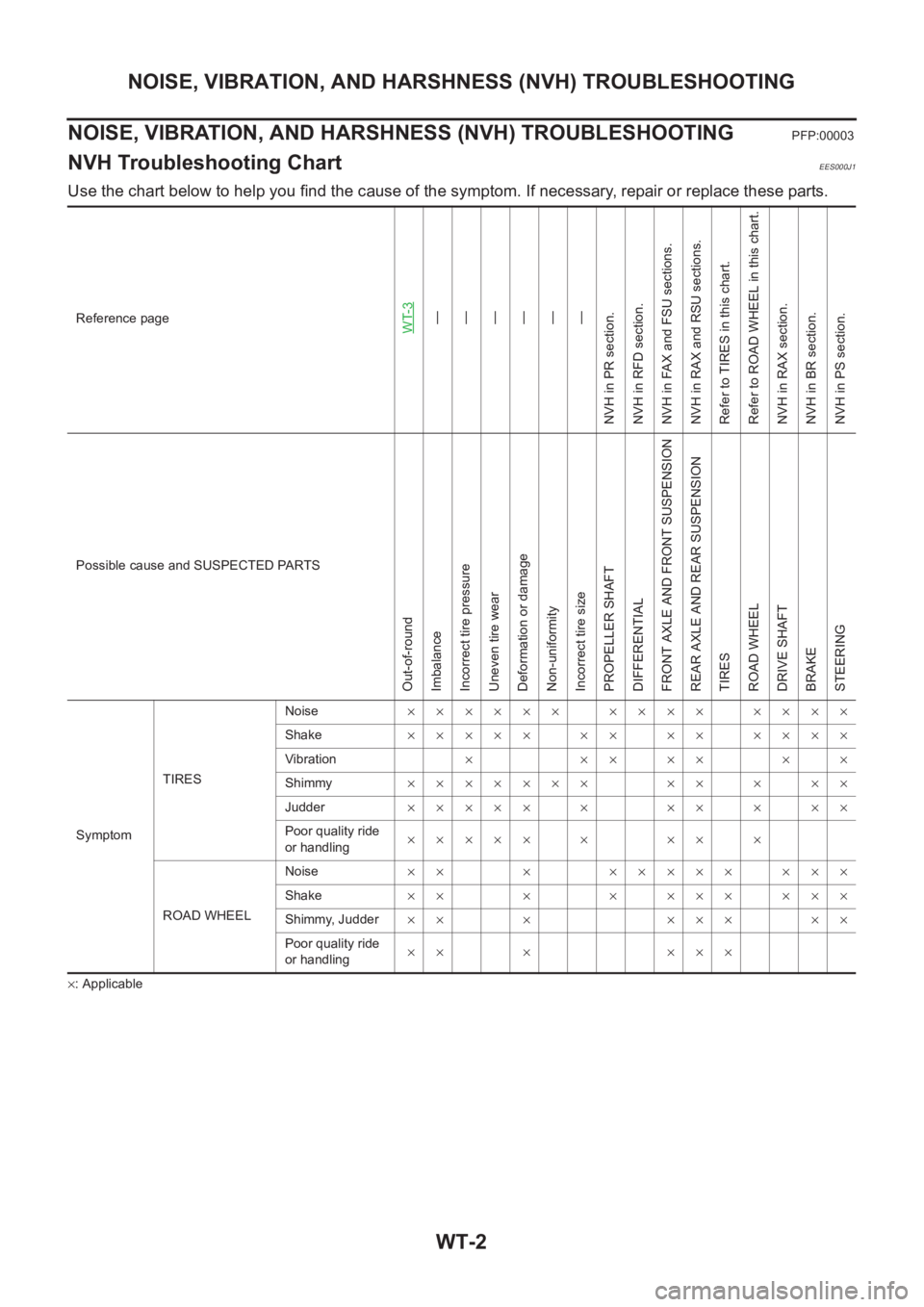2001 NISSAN X-TRAIL wheel size
[x] Cancel search: wheel sizePage 125 of 3833
![NISSAN X-TRAIL 2001 Service Repair Manual CYLINDER BLOCK
EM-75
[QR]
C
D
E
F
G
H
I
J
K
L
MA
EM
●A commercial engine stand can be used.
NOTE:
This example is an engine stand for holding at transaxle
mounting side with the flywheel or NISSAN X-TRAIL 2001 Service Repair Manual CYLINDER BLOCK
EM-75
[QR]
C
D
E
F
G
H
I
J
K
L
MA
EM
●A commercial engine stand can be used.
NOTE:
This example is an engine stand for holding at transaxle
mounting side with the flywheel or](/manual-img/5/57405/w960_57405-124.png)
CYLINDER BLOCK
EM-75
[QR]
C
D
E
F
G
H
I
J
K
L
MA
EM
●A commercial engine stand can be used.
NOTE:
This example is an engine stand for holding at transaxle
mounting side with the flywheel or drive plate removed.
3. Drain engine oil and engine coolant from inside of engine.
4. Remove the following components and associated parts.
●Exhaust manifold and three way catalyst assembly; Refer to
EM-24, "
EXHAUST MANIFOLD AND THREE WAY CATA-
LYST" .
●Intake manifold collector; Refer to EM-16, "INTAKE MANI-
FOLD" .
●Intake manifold and fuel tube assembly; Refer to EM-16, "INTAKE MANIFOLD" .
●Ignition coil; Refer to EM-29, "IGNITION COIL" .
●Rocker cover; Refer to EM-35, "ROCKER COVER" .
●Oil pan and oil strainer; Refer to EM-26, "OIL PAN AND OIL STRAINER" .
●Front cover, timing chain and balancer unit; Refer to EM-37, "TIMING CHAIN" .
●Camshaft; Refer to EM-46, "CAMSHAFT" .
●Cylinder head; Refer to EM-59, "CYLINDER HEAD" .
5. Remove knock sensor.
CAUTION:
Carefully handle the sensor avoiding shocks.
6. Remove crankshaft position sensor (POS).
CAUTION:
●Avoid impacts such as a dropping.
●Do not disassemble.
●Keep it away from metal particles.
●Do not place sensor close to magnetic materials.
7. Remove flywheel (M/T model) or drive plate (A/T model). Fix crankshaft with a stopper plate, and remove
mounting bolts.
Torx bit (size T55): Flywheel (M/T model)
Torx socket (size T55): Drive plate (A/T model)
CAUTION:
Be careful not to damage contact surface for the clutch disc
of the flywheel.
NOTE:
The flywheels, two block construction, allows movement in
response to transmission side pressure, or when twisted in its
rotational direction. Therefore, some amount of noise is normal.
PBIC0085E
SBIA0273E
KBIA0062E
Page 248 of 3833
![NISSAN X-TRAIL 2001 Service Repair Manual EM-198
[YD22DDTi]
CYLINDER BLOCK
CAUTION:
Apply new engine oil to parts marked in illustration before installation.
DISASSEMBLY
1. Remove engine assembly from the vehicle, then separate engine NISSAN X-TRAIL 2001 Service Repair Manual EM-198
[YD22DDTi]
CYLINDER BLOCK
CAUTION:
Apply new engine oil to parts marked in illustration before installation.
DISASSEMBLY
1. Remove engine assembly from the vehicle, then separate engine](/manual-img/5/57405/w960_57405-247.png)
EM-198
[YD22DDTi]
CYLINDER BLOCK
CAUTION:
Apply new engine oil to parts marked in illustration before installation.
DISASSEMBLY
1. Remove engine assembly from the vehicle, then separate engine and transaxle. Refer to EM-193,
"ENGINE ASSEMBLY" .
2. Remove clutch cover and disk. Refer to CL-15, "
CLUTCH DISC,
CLUTCH COVER AND FLYWHEEL" .
3. If they need to be replaced, replace pilot bushing.
●Using pilot bushing puller, remove the bushing from rear edge
of crankshaft.
4. Install engine to engine stand as follows.
a. Remove flywheel.
b. Secure ring gear with ring gear stopper, then loosen mounting
bolts with TORX bit (size: Q6T55 E9, Commercial Service Tools)
and remove them. As an alternative method hold the crankshaft
pulley with a pulley holder (SST) to remove the flywheel.
CAUTION:
Do not disassemble flywheel.
c. Install engine sub-attachment to the rear side of cylinder block.
●Align knock pins on cylinder block with pin holes on attach-
ment to install.
NOTE:
Installation bolts are part of engine sub-attachment.
d. Install engine attachment.
NOTE:
Use commercially available M12 (0.47 in) mounting bolts and
nuts (4 sets) with strength grade of 9T (minimum).
1. Rear oil seal retainer 2. Oil pressure switch 3. Copper washer
4. Oil jet relief valve 5. Cylinder block 6. Top ring
7. Second ring 8. Oil ring 9. Oil jet
10. Piston pin 11. Snap ring 12. Piston
13. Main bearing 14. Thrust bearing 15. Connecting rod
16. Key 17. Connecting rod bearing 18. Connecting rod cap
19. Connecting rod nut 20. Main bearing 21. Crankshaft
22. Main bearing cap 23. Pilot bush 24. Flywheel
25. Drain plug 26. Rear oil seal
SEM500G
SBIA0199E
JEM192G
Page 278 of 3833
![NISSAN X-TRAIL 2001 Service Repair Manual EM-228
[YD22DDTi]
SERVICE DATA AND SPECIFICATIONS (SDS)
AVAILABLE MAIN BEARING
Main bearing
Unit: mm (in)
Under size
Unit: mm (in)
AVAILABLE CONNECTING ROD BEARING
Connecting Rod Bearing
Unit: mm (in NISSAN X-TRAIL 2001 Service Repair Manual EM-228
[YD22DDTi]
SERVICE DATA AND SPECIFICATIONS (SDS)
AVAILABLE MAIN BEARING
Main bearing
Unit: mm (in)
Under size
Unit: mm (in)
AVAILABLE CONNECTING ROD BEARING
Connecting Rod Bearing
Unit: mm (in](/manual-img/5/57405/w960_57405-277.png)
EM-228
[YD22DDTi]
SERVICE DATA AND SPECIFICATIONS (SDS)
AVAILABLE MAIN BEARING
Main bearing
Unit: mm (in)
Under size
Unit: mm (in)
AVAILABLE CONNECTING ROD BEARING
Connecting Rod Bearing
Unit: mm (in)
Under size
Unit: mm (in)
MISCELLANEOUS COMPONENTS
Flywheel
Unit: mm (in)
*: Total indicator reading Grade number Thickness “T” Width “W” Identification color
0 1.816 - 1.820 (0.0715 - 0.0717)
19.9 - 20.1 (0.783 - 0.791)Black
1 1.820 - 1.824 (0.0717 - 0.0718) Brown
2 1.824 - 1.828 (0.0718 - 0.0720) Green
3 1.828 - 1.832 (0.0720 - 0.0721) Yellow
4 1.832 - 1.836 (0.0721 - 0.0723) Blue
SEM255G
Size Thickness Main journal diameter “Dm”
0.25 (0.0098) 1.949 - 1.953 (0.0767 - 0.0769)Grind so that bearing clearance is the
specified value.
Grade number Thickness “T” Width “W” Identification color (mark)
0 1.492 - 1.496 (0.0587 - 0.0589)
22.9 - 23.1
(0.902 - 0.909)Black
1 1.496 - 1.500 (0.0589 - 0.0591) Brown
2 1.500 - 1.504 (0.0591 - 0.0592) Green
Size Thickness Crank pin journal diameter “Dp”
0.08 (0.0031) 1.536 - 1.540 (0.0605 - 0.0606)
Grind so that bearing clearance is the
specified value. 0.12 (0.0047) 1.556 - 1.560 (0.0613 - 0.0614)
0.25 (0.0098) 1.621 - 1.625 (0.0638 - 0.0640)
Flywheel runout [TIR]*Standard 0.45 (0.0177) or less
Limit 1.3 (0.051) or less
Page 312 of 3833
![NISSAN X-TRAIL 2001 Service Repair Manual CO-6
[QR]
OVERHEATING CAUSE ANALYSIS
Except cool-
ing system
parts mal-
function— Overload on engineAbusive drivingHigh engine rpm under no
load
Driving in low gear for
extended time
Driving at e NISSAN X-TRAIL 2001 Service Repair Manual CO-6
[QR]
OVERHEATING CAUSE ANALYSIS
Except cool-
ing system
parts mal-
function— Overload on engineAbusive drivingHigh engine rpm under no
load
Driving in low gear for
extended time
Driving at e](/manual-img/5/57405/w960_57405-311.png)
CO-6
[QR]
OVERHEATING CAUSE ANALYSIS
Except cool-
ing system
parts mal-
function— Overload on engineAbusive drivingHigh engine rpm under no
load
Driving in low gear for
extended time
Driving at extremely high
speed
Powertrain system mal-
function
— Installed improper size
wheels and tires
Dragging brakes
Improper ignition timing
Blocked or restricted air
flowBlocked bumper —
— Blocked radiator grilleInstalled car brassiere
Mud contamination or
paper clogging
Blocked radiator —
Blocked condenser
Blocked air flow
Installed large fog lamp Symptom Check items
Page 332 of 3833
![NISSAN X-TRAIL 2001 Service Repair Manual CO-26
[YD22DDTi]
OVERHEATING CAUSE ANALYSIS
Except cool-
ing system
parts mal-
function— Overload on engineAbusive drivingHigh engine rpm under no
load
Driving in low gear for
extended time
Drivi NISSAN X-TRAIL 2001 Service Repair Manual CO-26
[YD22DDTi]
OVERHEATING CAUSE ANALYSIS
Except cool-
ing system
parts mal-
function— Overload on engineAbusive drivingHigh engine rpm under no
load
Driving in low gear for
extended time
Drivi](/manual-img/5/57405/w960_57405-331.png)
CO-26
[YD22DDTi]
OVERHEATING CAUSE ANALYSIS
Except cool-
ing system
parts mal-
function— Overload on engineAbusive drivingHigh engine rpm under no
load
Driving in low gear for
extended time
Driving at extremely high
speed
Powertrain system mal-
function
— Installed improper size
wheels and tires
Dragging brakes
Improper ignition timing
Blocked or restricted air
flowBlocked bumper —
— Blocked radiator grilleInstalled car brassiere
Mud contamination or
paper clogging
Blocked radiator —
Blocked condenser
Blocked air flow
Installed large fog lamp Symptom Check items
Page 2652 of 3833

TF-42
TROUBLE DIAGNOSIS
NOTE:
1. Light tight-corner braking symptom may occur depending on driving conditions in AUTO mode. This is not
malfunction.
2. Heavy tight-corner braking symptom occurs when vehicle is driven in the following conditions: LOCK
mode, steering wheel is turned fully to either sides, and accelerator pedal was depressed.
3. When the difference of revolution speed between the front and the rear wheels is large, the 4WD mode
does not change to other mode.this is not a malfunction.
4WD control unit input/output signal standardEDS000H9
4WD CONTROL UNIT CONNECTOR TERMINAL ARRANGEMENT
When ignition switch is turned to ON with connectors of 4WD control unit connected.
While driving, 4WD warning lamp
flashes rapidly. (when it flashes for
approx. one minute, then does not illu-
minate.) Rapid flashing: Two times
flashing per 1 secondEngine running
(to other than 2WD
mode)Protection function was activated due to heavy
load to electronically controlled coupling. (4WD
system is not malfunctioning.)TF-57, "
WHILE
DRIVING, 4WD
WARNING
LAMP
FLASHES RAP-
IDLY. (WHEN IT
FLASHERS
FOR APPROX.
ONE MINUTE,
THEN DOES
NOT ILLUMI-
NATE.)"
While driving, 4WD warning lamp
flashes slowly. (when it flashes for
approx. one minute, then does not illu-
minate.)Slow flashing: One flashing
per 2 seconds●Engine running
●Driving at vehicle
speed 20km/
h(12MPH)Tire size is different for front and rear of vehicle.TF-57, "
WHILE
DRIVING, 4WD
WARNING
LAMP
FLASHES
SLOWLY.
(WHEN IT
CONTINUES
TO ILLUMI-
NATE UNTIL
ENGINE
TURNS OFF.)"
Vehicle does not enter 4WD mode
even though 4WD warning lamp is off.Engine runningMechanical malfunction of electronically con-
trolled coupling (Mechanical engagement of
clutch is not possible.)TF-58, "
VEHI-
CLE DOES
NOT ENTER
4WD MODE
EVEN
THOUGH 4WD
WARNING
LAMP IS OFF."
Symptom Condition Check items Reference page
SDIA0120E
Page 2654 of 3833

TF-44
TROUBLE DIAGNOSIS
Specifications defined by CONSULT-II
Check air pressure of tire under normal condition.Items to be monitored ContentsData monitor
(Reference)
Check points when result
was malfunctioning ConditionReference values in
normal operation
DECEL G-SENSOR (G)G-sensor operating
conditionWith vehicle stopped
on flat road.± 0.15 G G-sensor and harness
THRTL POS SEN (V)Throttle valve open/
close conditionClosed throttle to wide
open throttleWhen closed throttle:
Approx. 0.5V
Throttle position sensor
and harness
When wide open throt-
tle: Approx. 4.0 V
ENGINE SPEED SIG
(STOP/RUN)With engine runningEngine speed below
400 rpmSTOP
Engine speed signal circuit
Engine speed 400 rpm
or higherRUN
E-TS ACTUATOR (ON/OFF)4WD actuator relay
(4WD actuator relay)
activation conditionVehicle stop (Ignition
switch ON)OFF4WD actuator relay (4WD
actuator relay) and har-
ness
Engine running ON
G-SEN VOLT (V)G-sensor power sup-
ply conditionWith vehicle stopped
on flat road.Approx. 8V (reference
value)G-sensor and harness
BATTERY VOL (V)Battery voltage sup-
plied to control unitIgnition switch ON Approx. 10 - 16 VControl unit power supply
circuit
4WD WARN LAMP (ON/
OFF)4WD warning lamp
ON condition4WD warning lamp
ONON4WD warning lamp and
harness
Refer to "4WD Warning
Lamp". 4WD warning lamp
OFFOFF
4WD MODE SW
(AUTO LOCK 2WD)Input condition of
4WD mode change-
over switchEngine running, vehi-
cle stopped, switch
pressed–4WD mode change-over
switch and circuit
4WD MODE MONI (AUTO,
LOCK, 2WD)Output condition of
4WD mode indicator
lamp signalEngine running, vehi-
cle stoppedUsing 4WD mode
change-over switch4WD mode indicator lamp
and circuit
DIS-TIRE MONI (mm)Improper size tire
installed condition
–0 - 4 mm, 4 - 8 mm,
8mm -Front/Rear tire size differ-
ence, wear condition
P BRAKE SW (ON/OFF)Parking brake switch
operating conditionParking brake
depressedON
Parking brake switch and
harness
Parking brake not
depressedOFF
SPEED MTR O/P (km/h)Output condition of
vehicle speed for
speedometerWhile vehicle is
stopped 0 km/h (0 MPH)
Speedometer and harness
Ve h i c le r u n n in gAlmost in accordance
with the wheel speed
sensor display
ABS 4WD COMMEPS/TCS/ABS con-
trol unit operating con-
ditionIgnition switch ON OKESP/TCS/ABS control unit
and circuit
CAN COMM (OK-NG)CAN communication
signal conditionIgnition switch ON OKCAN communication sig-
nal (OK-NG) condition is
displayed
Page 2736 of 3833

WT-2
NOISE, VIBRATION, AND HARSHNESS (NVH) TROUBLESHOOTING
NOISE, VIBRATION, AND HARSHNESS (NVH) TROUBLESHOOTING
PFP:00003
NVH Troubleshooting ChartEES000J1
Use the chart below to help you find the cause of the symptom. If necessary, repair or replace these parts.
×: ApplicableReference page
WT-3—
—
—
—
—
—
NVH in PR section.
NVH in RFD section.
NVH in FAX and FSU sections.
NVH in RAX and RSU sections.
Refer to TIRES in this chart.
Refer to ROAD WHEEL in this chart.
NVH in RAX section.
NVH in BR section.
NVH in PS section.
Possible cause and SUSPECTED PARTS
Out-of-round
Imbalance
Incorrect tire pressure
Uneven tire wear
Deformation or damage
Non-uniformity
Incorrect tire size
PROPELLER SHAFT
DIFFERENTIAL
FRONT AXLE AND FRONT SUSPENSION
REAR AXLE AND REAR SUSPENSION
TIRES
ROAD WHEEL
DRIVE SHAFT
BRAKE
STEERING
SymptomTIRESNoise×××××× ×××× ××××
Shake××××× ×× ×× ××××
Vibration×××××××
Shimmy××××××× ×× × ××
Judder××××× × ×× × ××
Poor quality ride
or handling××××× × ×× ×
ROAD WHEELNoise×× × ××××× ×××
Shake×× × × ××× ×××
Shimmy, Judder×× × ××× ××
Poor quality ride
or handling×× × ×××